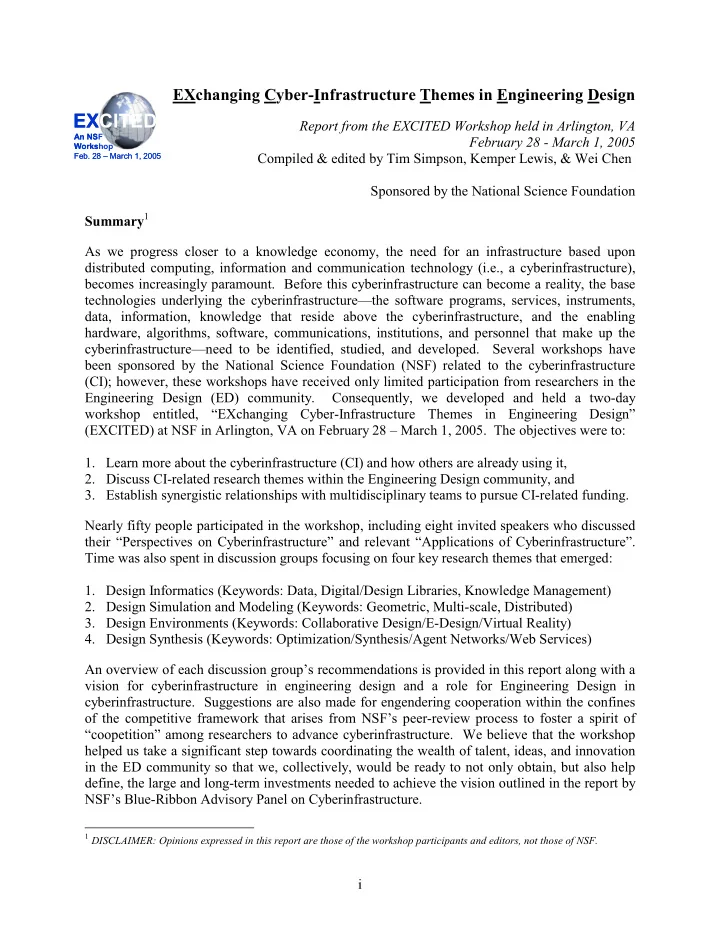

EXchanging Cyber-Infrastructure Themes in Engineering Design EXCITED EXCITED Report from the EXCITED Workshop held in Arlington, VA An NSF An NSF February 28 - March 1, 2005 Workshop Workshop Compiled & edited by Tim Simpson, Kemper Lewis, & Wei Chen Feb. 28 – March 1, 2005 Feb. 28 – March 1, 2005 Sponsored by the National Science Foundation Summary 1 As we progress closer to a knowledge economy, the need for an infrastructure based upon distributed computing, information and communication technology (i.e., a cyberinfrastructure), becomes increasingly paramount. Before this cyberinfrastructure can become a reality, the base technologies underlying the cyberinfrastructure—the software programs, services, instruments, data, information, knowledge that reside above the cyberinfrastructure, and the enabling hardware, algorithms, software, communications, institutions, and personnel that make up the cyberinfrastructure—need to be identified, studied, and developed. Several workshops have been sponsored by the National Science Foundation (NSF) related to the cyberinfrastructure (CI); however, these workshops have received only limited participation from researchers in the Engineering Design (ED) community. Consequently, we developed and held a two-day workshop entitled, “EXchanging Cyber-Infrastructure Themes in Engineering Design” (EXCITED) at NSF in Arlington, VA on February 28 – March 1, 2005. The objectives were to: 1. Learn more about the cyberinfrastructure (CI) and how others are already using it, 2. Discuss CI-related research themes within the Engineering Design community, and 3. Establish synergistic relationships with multidisciplinary teams to pursue CI-related funding. Nearly fifty people participated in the workshop, including eight invited speakers who discussed their “Perspectives on Cyberinfrastructure” and relevant “Applications of Cyberinfrastructure”. Time was also spent in discussion groups focusing on four key research themes that emerged: 1. Design Informatics (Keywords: Data, Digital/Design Libraries, Knowledge Management) 2. Design Simulation and Modeling (Keywords: Geometric, Multi-scale, Distributed) 3. Design Environments (Keywords: Collaborative Design/E-Design/Virtual Reality) 4. Design Synthesis (Keywords: Optimization/Synthesis/Agent Networks/Web Services) An overview of each discussion group’s recommendations is provided in this report along with a vision for cyberinfrastructure in engineering design and a role for Engineering Design in cyberinfrastructure. Suggestions are also made for engendering cooperation within the confines of the competitive framework that arises from NSF’s peer-review process to foster a spirit of “coopetition” among researchers to advance cyberinfrastructure. We believe that the workshop helped us take a significant step towards coordinating the wealth of talent, ideas, and innovation in the ED community so that we, collectively, would be ready to not only obtain, but also help define, the large and long-term investments needed to achieve the vision outlined in the report by NSF’s Blue-Ribbon Advisory Panel on Cyberinfrastructure. 1 DISCLAIMER: Opinions expressed in this report are those of the workshop participants and editors, not those of NSF. i
Table of Contents Summary.......................................................................................................................................... i Table of Contents............................................................................................................................ ii 1. Motivation for the Workshop...................................................................................................... 1 2. Workshop Overview................................................................................................................... 2 2.1. Workshop Participants.......................................................................................................... 2 2.2. Invited Speakers ................................................................................................................... 3 3. Discussion Groups and Their Recommendations....................................................................... 5 3.1. Design Informatics in the Cyberinfrastructure..................................................................... 5 3.2. Design Simulation and Modeling in the Cyberinfrastructure............................................... 7 3.3. Design Environments in the Cyberinfrastructure................................................................. 9 3.4. Design Synthesis in the Cyberinfrastructure ...................................................................... 11 4. Cyberinfrastructure in Engineering Design and Engineering Design in Cyberinfrastructure .. 13 Closing Remarks........................................................................................................................... 14 Acknowledgments......................................................................................................................... 15 References..................................................................................................................................... 15 Appendix A: Workshop Agenda................................................................................................... 16 Appendix B: Workshop Participants and Discussion Groups ...................................................... 17 Appendix C: Summary Slides from Discussion Groups............................................................... 18 ii
EXchanging Cyber-Infrastructure Themes in Engineering Design EXCITED EXCITED Report from the EXCITED Workshop held in Arlington, VA An NSF An NSF February 28 - March 1, 2005 Workshop Workshop Feb. 28 – March 1, 2005 Feb. 28 – March 1, 2005 Sponsored by the National Science Foundation 1. Motivation for the Workshop As we progress closer to a knowledge economy, the need for an infrastructure based upon distributed computing, information and communication technology (i.e., a cyberinfrastructure), becomes increasingly paramount. Before this cyberinfrastructure can become a reality, the base technologies underlying the cyberinfrastructure—the software programs, services, instruments, data, information, knowledge that reside above the cyberinfrastructure, and the enabling hardware, algorithms, software, communications, institutions, and personnel that make up the cyberinfrastructure—need to be identified, studied, and developed. In the report by Atkins, et al. on cyberinfrastructure 2 , a major conclusion was that “highly coordinated, large, and long-term investment” was necessary for research, development, and implementation. Many people in Engineering Design (ED) are uniquely poised to address many of the research and implementation issues in the underlying technologies needed to realize a cyberinfrastructure, but the collection of diverse strengths and competencies in the ED community creates unique and difficult challenges in the identification, prioritization, and strategic management of future research foci, projects, and teams of excellence within the collective community. Several workshops have been sponsored by the National Science Foundation (NSF) related to the cyberinfrastructure, including 3 : • “Cyberinfrastructure for Engineering Research and Education” Workshop, June 5-6, 2003, NSF, Arlington, VA • “Research Opportunities in CyberEngineering/CyberInfrastructure” the Third NSF Workshop, April 22-23, 2004, Drexel University, Philadelphia, PA • “ENG, ITR and Cyberinfrastructure”, June 11, 2004, ENG Breakout Session, NSF ITR Grantees Workshop, Arlington, VA • “Multi-disciplinary Workshop at the Interface of CI, OR”, August 30-31, 2004, Washington, D.C. Unfortunately, these workshops have received only limited participation from researchers in the ED community despite the best efforts of the various organizing committees to include them. Our goal, in preparing the EXCITED workshop, was to draw heavily from the ED community while inviting representatives from these other workshops to speak and participate at the EXCITED Workshop to help get the ED community “up to speed”. As stated by Dr. William C. Regli at the workshop, “engineering design is ‘cyber-trailing’ [the] CS/CE/ECE/IT/IS disciplines significantly,” and we hope that this report will help unite researchers within the ED community 2 Available on-line at: http://www.cise.nsf.gov/sci/reports/atkins.pdf. 3 This information was gathered from: http://www.nsf.gov/crssprgm/ci-team/. 1
Recommend
More recommend